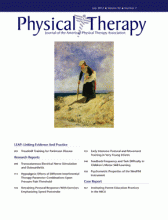Abstract
Background Little evidence exists regarding parameter selection for hypoalgesia using interferential therapy (IFT).
Objective This study investigated segmental and extrasegmental hypoalgesic effects of different IFT parameter combinations upon experimentally induced pressure pain threshold (PPT) in pain-free volunteers.
Design The participants were randomly assigned to 6 groups: control, placebo, bipolar constant amplitude modulation frequency (AMF), bipolar sweep AMF, quadripolar constant AMF, and quadripolar sweep AMF.
Setting The study was conducted in a university laboratory.
Participants One hundred eighty adults who were healthy and pain-free participated in the study.
Intervention Interferential therapy was delivered to all groups at high, to-tolerance intensity and at high AMF. Stimulation to the dominant forearm was delivered for 30 minutes, with monitoring for a further 30 minutes.
Measurements Pain pressure threshold was measured at the area of first dorsal interosseous muscle of the dominant and nondominant hands (segmental measurements) and over the tibialis anterior muscle (extrasegmental measurement) at baseline and at 10-minute intervals using a pressure algometer. Square root transformed PPT data were analyzed using repeated-measures analysis of variance.
Results There was a significant change in PPT over time, but no significant between-subjects difference in segmental or extrasegmental PPT between any of the IFT groups and the placebo or control group. Thus, IFT delivered in any of these parameter combinations did not significantly affect the PPT of pain-free participants compared with the control or placebo group.
Limitations Success of blinding was not evaluated.
Conclusions This study showed that IFT delivered at high, to-tolerance intensity and high AMF does not produce significant segmental and extrasegmental hypoalgesic effects on PPT in participants who were healthy compared with a control or placebo group. Further research is warranted to investigate the hypoalgesic effect of different IFT parameter combinations and to explain its possible mechanism of action.
Footnotes
All authors provided concept/idea/research design, project management, and consultation (including review of manuscript before submission). Dr Dounavi, Dr Chesterton, and Dr Sim provided writing. Dr Dounavi provided data collection. Dr Sim provided data analysis. Dr Chesterton provided fund procurement. The authors thank Dr Panos Barlas for advice on the design and conduct of this study.
The study was approved by the Ethics Committee of the School of Health and Rehabilitation, Keele University.
- Received April 2, 2011.
- Accepted March 26, 2012.












